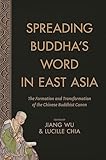Spreading Buddha's Word in East Asia : The Formation and Transformation of the Chinese Buddhist Canon / ed. by Lucille Chia, Jiang Wu.
Material type: TextSeries: The Sheng Yen Series in Chinese Buddhist StudiesPublisher: New York, NY : Columbia University Press, [2015]Copyright date: ©2015Description: 1 online resource (432 p.) : 30 b&w photographsContent type:
TextSeries: The Sheng Yen Series in Chinese Buddhist StudiesPublisher: New York, NY : Columbia University Press, [2015]Copyright date: ©2015Description: 1 online resource (432 p.) : 30 b&w photographsContent type: - 9780231171601
- 9780231540193
- 294.3/820951 23/eng/20230216
- BQ1217 .S77 2016
- online - DeGruyter
| Item type | Current library | Call number | URL | Status | Notes | Barcode | |
|---|---|---|---|---|---|---|---|
 eBook
eBook
|
Biblioteca "Angelicum" Pont. Univ. S.Tommaso d'Aquino Nuvola online | online - DeGruyter (Browse shelf(Opens below)) | Online access | Not for loan (Accesso limitato) | Accesso per gli utenti autorizzati / Access for authorized users | (dgr)9780231540193 |
Frontmatter -- Preface -- Contents -- Acknowledgments -- Conventions -- Introduction -- 1. The Chinese Buddhist Canon Through the Ages -- 2. From the “Cult of the Book” to the “Cult of the Canon” -- 3. Notions and Visions of the Canon in Early Chinese Buddhism -- 4. Fei Changfang’s Records of the Three Treasures Throughout the Successive Dynasties (Lidai sanbao ji) and Its Role in the Formation of the Chinese Buddhist Canon -- 5. The Birth of the First Printed Canon -- 6. The Life and Afterlife of Qisha Canon (Qishazang) -- 7. Managing the Dharma Treasure -- 8. Better Than the Original -- 9. Taishō Canon -- Appendix 1. A Brief Survey of the Printed Editions of the Chinese Buddhist Canon -- Appendix 2. The Creation of the CBETA Chinese Electronic Tripitaka Collection in Taiwan -- Bibliography -- List of Contributors -- Index
restricted access online access with authorization star
http://purl.org/coar/access_right/c_16ec
A monumental work in the history of religion, the history of the book, the study of politics, and bibliographical research, this volume follows the making of the Chinese Buddhist canon from the fourth century to the digital era. Approaching the subject from a historical perspective, it ties the religious, social, and textual practices of canon formation to the development of East Asian Buddhist culture and enlivens Chinese Buddhist texts for readers interested in the evolution of Chinese writing and the Confucian and Daoist traditions.The collection undertakes extensive readings of major scriptural catalogs from the early manuscript era as well as major printed editions, including the Kaibao Canon, Qisha Canon, Goryeo Canon, and Taisho Canon. Contributors add fascinating depth to such understudied issues as the historical process of compilation, textual manipulation, physical production and management, sponsorship, the dissemination of various editions, cultic activities surrounding the canon, and the canon's reception in different East Asian societies. The Chinese Buddhist canon is one of the most enduring textual traditions in East Asian religion and culture, and through this exhaustive, multifaceted effort, an essential body of work becomes part of a new, versatile narrative of East Asian Buddhism that has far-reaching implications for world history.
Mode of access: Internet via World Wide Web.
In English.
Description based on online resource; title from PDF title page (publisher's Web site, viewed 06. Mrz 2024)


